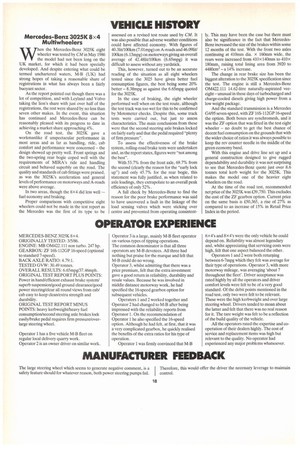OPERATOR EXPERIENCE
Page 126

If you've noticed an error in this article please click here to report it so we can fix it.
MERCEDES-BENZ 3025K 8x4. ORIGINALLY TESTED: 3/5/86.
ENGINE: MB 0M422.111 non turbo. 247 hp. GEARBOX: ZF 16S-112GP 16-speed (optional to standard 7-speed). BACK AXLE RATIO: 4.79:1.
TESTED GVW: 30.49 tonnes,
OVERALL RESULTS: 6.65mpg/37.46mph. ORIGINAL TEST REPORT PLUS POINTS: Power in hand/efficient exhaust brake system/ superb suspension/good ground clearance/good power steering/clear all round views from cab/ cab easy to keep clean/extra strength and durability. ORIGINAL TEST REPORT MINUS POINTS: heavy kerbweight/heavy fuel consumption/second steering axle brakes lock easily/brake pedal requires firm pressure/overlarge steering wheel.
Operator 1 has a five vehicle M-B fleet on regular local delivery quarry work. Operator 2 is an owner driver on similar work.
Operator 3 is a large, mainly M-B fleet operator on various types of tipping operations. The common denominator is that all three operators are M-B devotees. All three had nothing but praise for the marque and felt that M-B could do no wrong.
Operator 3, whilst admitting that there was a price premium, felt that the extra investment gave a good return in reliability, durability and resale values. Because he was involved in middle distance motorway work, he had specified the 16-speed gearbox option for subsequent vehicles.
Operators 1 and 2 worked together and Operator 2 had changed to M-B after being impressed with the reliability reports from Operator I. On the recommendation of Operator I he also specified the 16-speed option. Although he had felt, at first, that it was a very complicated gearbox, he quickly realised the benefits of the extra ratios for his type of operation.
Operator 1 was firmly convinced that M-B 6x 4's and 8<4's were the only vehicle he could depend on. Reliability was almost legendary and, whilst appreciating that servicing costs were high, felt that one aspect balanced the other.
Operators 1 and 2 were both returning between 6-7mpg which they felt was average for their type of operations. Operator 3, with more motorway mileage, was averaging 'about 7 throughout the fleet'. Driver acceptance was rated highly by all the operators and driver comfort levels were felt to be of a very good standard. Of the debit points mentioned in the road test, only two were felt to be relevant. These were the high kerbweight and over large steering wheel. Drivers tended to moan about the latter and felt that there was no real reason for it. The tare weight was felt to be a reflection of the build quality of the vehicle. Al] the operators rated the expertise and cooperation of their dealers highly. The cost of service and replacement items was high but relevant to the quality. No operator had experienced any major problems whatsoever.












































































































































